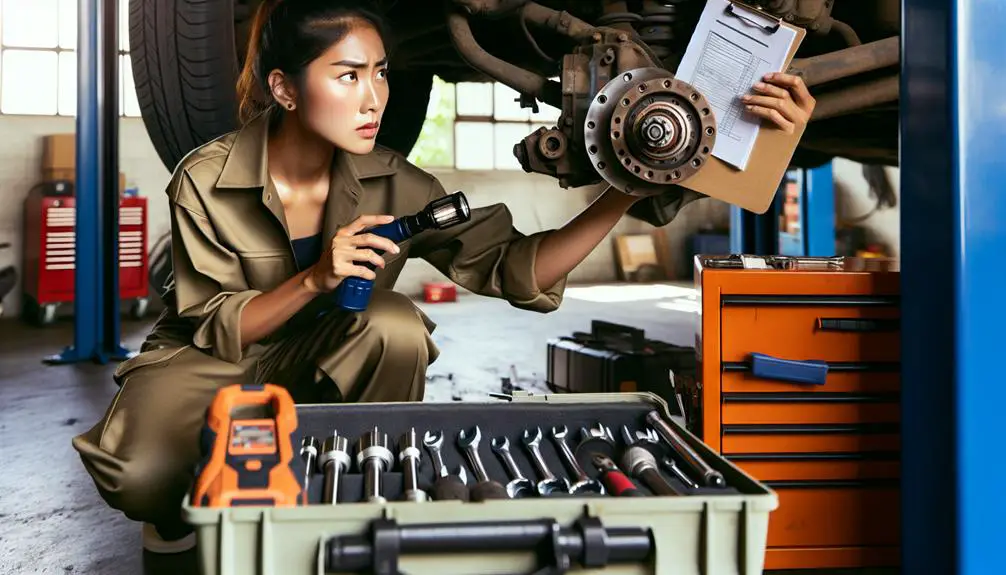To fix an axle, first identify signs of damage, then gather necessary tools.
The crucial step before removing and replacing the axle is ensuring you have all the correct parts and understanding the process to avoid incomplete repairs.
Identifying Axle Damage

To fix an axle, spotting damage signs early is important. This can save time, money, and prevent accidents. Look for these symptoms of axle problems:
- Strange noises, like loud clanking or clicking when turning, suggest CV joint issues affecting the axle. Don’t ignore these sounds.
- If your car vibrates more than usual, especially at certain speeds or during acceleration, it might mean the axle is bent or damaged. A smooth ride indicates everything is okay, so vibrations are a warning sign.
- Problems with vehicle performance, such as difficulty accelerating or resistance when driving, could be due to an axle issue. This happens when the axle struggles to transfer engine power to the wheels.
- Visually check the axle for damage or wear. Grease leaking from a torn CV boot indicates axle problems that need quick attention.
Spotting these signs early can help maintain your vehicle’s health and safety.
Gathering Necessary Tools
To fix an axle, collect the necessary tools first. You need a good jack and jack stands to lift your vehicle safely. Get wrenches and sockets that match your vehicle’s needs, either metric or standard. A torque wrench is important for applying the right torque to the axle nut. Use a breaker bar for extra leverage on tight axle nuts.
Wear safety glasses to protect your eyes from dirt and debris. Have pliers and a screwdriver set ready for removing clips or covers. A rubber mallet can help you position parts without causing damage.
Preparing these tools before starting saves time and helps in fixing the axle effectively. Having the right tools is essential for the job.
Removing the Damaged Axle

After gathering all tools, proceed to remove the damaged axle from your vehicle. Ensure the vehicle is safely lifted and supported.
Begin by loosening the lug nuts before lifting the car, then remove them completely once the car is lifted. This gives clear access to the axle.
- Lift the car and ensure it’s on jack stands.
- Take off the brake caliper and rotor carefully to avoid damage. Hang the caliper with a wire to not strain the brake hose.
- Use a breaker bar or impact wrench to remove the axle nut if it’s tight.
- Pry the axle shaft from the differential or transmission. If difficult, use a rubber mallet to tap it gently.
- Carefully slide the axle shaft out of the hub assembly, keeping it steady.
Keep track of all removed parts for easier reassembly. Don’t force any components. If something isn’t coming apart, check for any missed fasteners or clips. Be patient to avoid further damage.
Installing the New Axle
Remove the old axle and install the new one, making sure it fits correctly into the hub assembly.
First, carefully position the new axle into the hub without forcing it. Rotate it slightly while pushing it in to align it properly. If it doesn’t go in easily, check for obstructions.
Next, connect the axle to the differential or transmission. Line it up with the internal splines and push until it clicks into place. You may need to wiggle it a bit. Ensure the retaining clip is in place to keep the axle secure.
Lastly, reattach any removed components like the brake assembly, wheel, and suspension parts. Tighten all bolts and nuts to their correct torque settings.
Performing Final Checks

After installing a new axle and reattaching all parts, it’s important to check everything is aligned and working right. This step is crucial for the safety and performance of your vehicle. Here’s what to do in the final checks:
- Visual Check: Look at the axle and surrounding area for any damage or misalignment. Everything should look good and undamaged.
- Bolt and Nut Tightness: Make sure all bolts and nuts are tight according to the manufacturer’s specifications. Use a torque wrench for accurate tightness.
- Brake System Check: Ensure the brake system, including brake lines and ABS sensors if present, is connected properly. Brakes are key for safety.
- Wheel Alignment Check: Even though perfect alignment mightn’t be possible by yourself, ensure nothing looks wrong. Get a professional alignment soon.
- Test Drive: Drive your vehicle carefully and listen for any strange noises. Pay attention to the handling. Any problems should lead to checking your work again.
These checks are essential to ensure your work is done correctly and your vehicle is safe to drive.
Conclusion
After you know what’s wrong, have your tools, and have taken out the old axle, putting in the new one is easy. Just make sure you did every step right so there are no problems.
Once the new axle is in, double-check everything to make sure it’s all working fine. By doing this, you’ve fixed your axle and saved both time and money.
Remember, taking care of your car often can help stop problems like this from happening later.